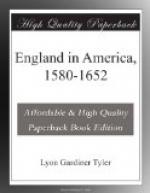Claiborne, naturally indignant and not suspecting any danger, sailed for England in May, 1637, to settle accounts with his partners, having just previously established another settlement on Palmer’s Island at the mouth of the Susquehanna River, believed by him to be north of the Maryland patent. After he was gone, Evelin tried to persuade the inhabitants to disown Claiborne and submit to Lord Baltimore; and when they declined he urged Governor Calvert to attempt the reduction of the island by force. After some hesitation the latter consented, and while the assembly was sitting at St. Mary’s, in February, 1638, Calvert made a landing at night with thirty men, and, taking the inhabitants by surprise, succeeded in reducing the island to submission.[10]
Calvert’s after-conduct reflects little credit upon his reputation for leniency. In March, 1638, he caused Claiborne to be attainted by the assembly as a rebel and his property confiscated, and Thomas Smith, who commanded one of Claiborne’s pinnaces in the battles three years before, was tried and hanged for murder and piracy.[11] In England, in the mean time, Claiborne and Baltimore were contending zealously for the favor of the king. Both had powerful interests behind them, but Baltimore’s were the stronger. At last the Commissioners for Foreign Plantations rendered a report (April 4, 1638), giving Kent Island and the right of trade in the bay wholly to Lord Baltimore, leaving all personal wrongs to be redressed by the courts.
The question of title at least seemed settled, and in October, 1638, Sir John Harvey, now restored as governor of Virginia, issued a proclamation recognizing the validity of the decision. Claiborne submitted, and, being left to “the course of the law,” empowered George Scovell to recover, if possible, some of the confiscated property in Maryland; but Scovell was told that the law-courts of Maryland were closed against such a rebel as Claiborne.[12] The justice of the English decision depends on the impartiality of the board which made it, and of any board with Bishop Laud at the head only partisanship could be expected.
While these turbulent proceedings were going on, the Jesuit priests introduced into the colony by Lord Baltimore were performing a work of peace and love. They visited the Indian tribes and made many Christian converts. Tayac, chief of the Piscataquas, received baptism, and his example was followed by the chiefs and inhabitants of Port Tobacco. The main trouble came from the Nanticokes on the eastern shore, and the fierce Susquehannas to the north of the settlements, and at different times armed expeditions were sent out against them; but there was nothing like a war.




